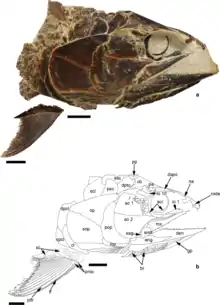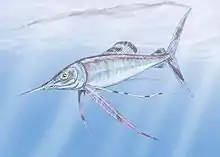Pachycormiformes
Pachycormiformes are an extinct order of marine ray-finned fish known from Mesozoic deposits from Eurasia, the Americas and Antarctica. They were characterized by having serrated pectoral fins (though more recent studies demonstrated that fin shape diversity in this group was high[1]), reduced pelvic fins and a bony rostrum. Their exact relations with other fish are unclear, but they are generally though to be more closely related to teleosts than to Amiiformes. Pachycormiformes are morphologically diverse, containing both tuna-like carnivorous and edentulous suspension-feeding forms, the latter including the largest ray finned fish known to have existed, Leedsichthys.
| Pachycormiformes | |
|---|---|
 | |
| 3-dimensionally preserved head and forefin of Pachycormus | |
| Scientific classification | |
| Kingdom: | Animalia |
| Phylum: | Chordata |
| Class: | Actinopterygii |
| Division: | †Aspidorhynchei |
| Order: | †Pachycormiformes Berg 1937 |
| Type genus | |
| Pachycormus Agassiz, 1833 | |
| Subgroupings | |
|
See text | |

Synapomorphies
Pachycormiformes are united by "a compound bone (rostrodermethmoid) forming the anterodorsal border of the mouth; a reduced coronoid process of the mandible; absence of supraorbitals associated with a dermosphenotic defining the dorsal margin of the orbit; two large, plate-like suborbital bones posterior to the infraorbitals; long, slender pectoral fins; asymmetrical branching of pectoral fin lepidotrichia; considerable overlap of the hypurals by caudal fin rays (hypurostegy); and the presence of distinctive uroneural-like ossifications of the caudal fin endoskeleton"[2]
Taxonomy
- Order †Pachycormiformes Berg 1937 [Pachycormida][3][4][5]
- Family †Pachycormidae Woodward 1895 [Protosphyraenidae Cope 1875; Erisichtheidae Cope 1877; Pelecopteridae Cope 1875; Saurostomini Bonaparte 1846 corrig. Bonaparte 1850a; Sauropsidae Cope 1877a; Microlepidoti Zittel 1887] Taxonomy according to[6]
- Genus †Euthynotus Wagner 1860 [Heterothrissops le Sauvage 1875; Pseudothrissops Sauvage 1875]
- Genus †Pachycormus Agassiz 1833 non Coville ex Standley 1923 [?Pachylepis Quenstedt 1858 non Pander 1856; ?Lycodus Quenstedt 1856]Genus †Saurostomus Agassiz 1843
- Genus †Saurostomus Agassiz 1843
- Genus †Ohmdenia Hauff 1953
- Suspension feeding clade
- Genus †Martillichthys Liston 2008
- Genus †Asthenocormus Woodward 1895 [Agassizia Vetter 1881 non Agassiz & Desor 1847 non Behr 1870 non Yoshiyasu 1987]
- Genus †Bonnerichthys Friedman et al. 2010
- Genus †Leedsichthys Woodward 1889 [Leedsia Woodward 1890]
- Genus †Rhinconichthys Friedman et al. 2010
- Genus †Hypsocormus Wagner 1860
- Macrocarnivore clade
- Genus †Orthocormus Weitzel 1930
- Genus †Australopachycormus Kear 2007
- Genus †Protosphyraena Leidy 1857 [Erisichthe Cope 1872; Pelecopterus Cope 1875]
- Macrocarnivore clade
- Genus †Saurostomus Agassiz 1843
- Genus †Pachycormus Agassiz 1833 non Coville ex Standley 1923 [?Pachylepis Quenstedt 1858 non Pander 1856; ?Lycodus Quenstedt 1856]Genus †Saurostomus Agassiz 1843
- Genus †Euthynotus Wagner 1860 [Heterothrissops le Sauvage 1875; Pseudothrissops Sauvage 1875]
- Family †Pachycormidae Woodward 1895 [Protosphyraenidae Cope 1875; Erisichtheidae Cope 1877; Pelecopteridae Cope 1875; Saurostomini Bonaparte 1846 corrig. Bonaparte 1850a; Sauropsidae Cope 1877a; Microlepidoti Zittel 1887] Taxonomy according to[6]
Cladistics according to Friedman et al. (2010).[7]
| |||||||||||||||||||||||||||||||||||||||||||||||||||||||||||||
Sources/external links
- http://www.courtenaymuseum.ca/paleo/paleo/pachycor.html
- https://web.archive.org/web/20081025044133/http://www.palaeos.com/Vertebrates/Units/100Neopterygii/100.600.html
- Sepkoski, Jack (2002). "A compendium of fossil marine animal genera". Bulletins of American Paleontology. 363: 1–560. Retrieved 2011-05-17.
- "Pachycormiformes". Paleobiology Database. Retrieved November 11, 2012.
References
- Liston, Jeff J.; Maltese, Anthony E.; Lambers, Paul H.; Delsate, Dominique; Harcourt-Smith, William E. H.; Heteren, Anneke H. van (2019-11-07). "Scythes, sickles and other blades: defining the diversity of pectoral fin morphotypes in Pachycormiformes". PeerJ. 7: e7675. doi:10.7717/peerj.7675. ISSN 2167-8359. PMC 6842561. PMID 31720097.
- Dobson, Claire; Giles, Sam; Johanson, Zerina; Liston, Jeff; Friedman, Matt (2019-09-03). "Cranial osteology of the Middle Jurassic (Callovian) Martillichthys renwickae (Neopterygii, Pachycormiformes) with comments on the evolution and ecology of edentulous pachycormiforms". Papers in Palaeontology. doi:10.1002/spp2.1276. ISSN 2056-2802.
- Haaramo, Mikko (2007). "†Pachycormiformes". Mikko's Phylogeny Archive. Retrieved 30 December 2016.
- Nelson, Joseph S.; Grande, Terry C.; Wilson, Mark V. H. (2016). Fishes of the World (5th ed.). John Wiley & Sons. ISBN 9781118342336.
- van der Laan, Richard (2016). "Family-group names of fossil fishes". Cite journal requires
|journal=(help) - Wretman, Lovisa; Blom, Henning; Kear, Benjamin P. (2016-09-02). "Resolution of the Early Jurassic actinopterygian fish Pachycormus and a dispersal hypothesis for Pachycormiformes". Journal of Vertebrate Paleontology. 36 (5): e1206022. doi:10.1080/02724634.2016.1206022. ISSN 0272-4634. S2CID 89338085.
- Matt Friedman; Kenshu Shimada; Larry D. Martin; Michael J. Everhart; Jeff Liston; Anthony Maltese; Michael Triebold (2010). "100-million-year dynasty of giant planktivorous bony fishes in the Mesozoic seas". Science. 327 (5968): 990–993. doi:10.1126/science.1184743. PMID 20167784. S2CID 206524637.